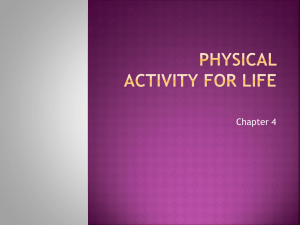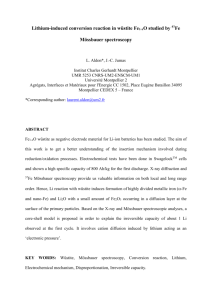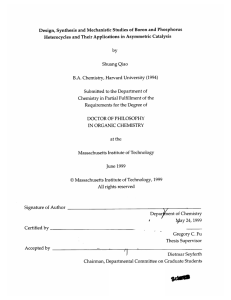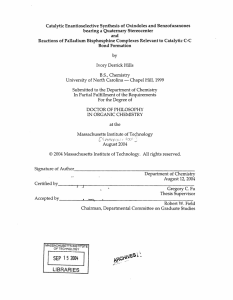PowerPoint slides - C-MORE
advertisement
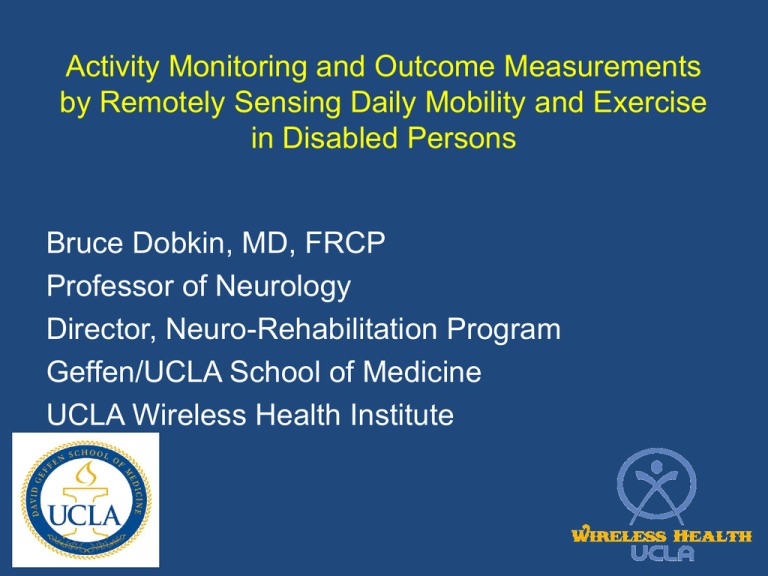
Activity Monitoring and Outcome Measurements by Remotely Sensing Daily Mobility and Exercise in Disabled Persons Bruce Dobkin, MD, FRCP Professor of Neurology Director, Neuro-Rehabilitation Program Geffen/UCLA School of Medicine UCLA Wireless Health Institute mHealth Definition: Delivery of healthcare services via mobile communication devices. Opportunity: By 2017, more mobile phones than people on the planet; currently three-quarters of the world’s population have access to a mobile phone. Goal: Facilitate medical and health information via instantaneous communication anywhere/anytime. Reduce disparities, prevent disease, improve diagnostics & therapy, increase adherence, personalize medical advice in chronic diseases, enhance research & daily care, merge diverse data sets, lower costs. UCLA WHI Strategies • Develop reliable, highly valued tools to improve outcomes in healthcare. • Deploy the intellectual resources of the UCLA medical, nursing, engineering, public health and other schools and depts. • Encourage faculty and students to identify needs, ideas and pilot studies. • Design and Test: Use an iterative approach to identify opportunities, develop and test user-friendly tools, and show the efficacy of sensors (or other WHI devices) within scientifically conducted clinical trials on likely users. • Serve as an incubator for wireless health ventures. Lots of activity sensors, but where is the beef? Fitbit Flex Basis Band BodyMedia Core2 Armband & Vue Patch Withings Smart Activity Tracker PerformTek Fitbug Orb Fitlinxx Pebble MDAWN Medical Daily Activity Wireless Network An inexpensive, wireless sensor/algorithm system that can remotely recognize and quantify purposeful behaviors such as walking, exercise, and skills practice, as well as provide feedback about performance, in persons with impaired mobility. Our niche: within clinical trials across diseases, improve outcomes for disabled persons Monitor skills practice, exercise, & mobility activities in the home and community for compliance and safety, and to audit clinical trial interventions. Develop outcome measures with continuous, rather than ordinal scales; quantify the type, intensity, and quality of mobility. Capture gains and declines in purposeful activities in the real world, not just in the unnatural environment of a lab and not with the ambiguity of self-report scales. Remote Sensing Systems Accelerometer Magnetometer Sensor RFID Contact, EMG, Goniometer Hidden Markov Model Naïve Bayes Neural Classifiers Nearest Fusion Networks Neighbor Gyroscope Decision Tree Ambient Sound & Visuals Singular Spectrum Analysis Gait Analysis; Mean of Signal Athletic Training Falls Correlation Type, Quantity, of Axis Application Quality of Activity Features NeuroPeak Rehabilitation Frequency Daily Activity Std. Dev. Monitoring & Energy of Signal Motor Control Feedback Ankle accelerometers can describe walking, cycling, exercises, and overall activity in the home and community at low cost. Dobkin & Dorsch. Neurorehabil Neural Repair, 2011 MDAWN for Disabled Persons • Based upon two 10-meter walks, machinelearning algorithms enable a template for each participant that identifies subsequent episodes of walking or exercise throughout the day. • Gait parameters include walking speed, duration, distance, and limb asymmetries, which are calculated for each walking episode. 77 year-old with chronic left hemiplegic stroke Walking speed is 0.1m/s Stroke Inpatient Rehabilitation Reinforcement of ACTivity (SIRRACT) • Can clinicians improve walking-related outcomes during hospital-based rehab? • International RCT. • Wear ankle sensors. • Compared 2 levels of daily feedback about performance. Presented at AAN, 3/13 • 140 subjects at 15 sites. • Showed increasing amount of walking and walking speed from admission to discharge. • Rather low mean daily amount of training was detected. • Proved ease of use, accuracy, relevance of the data. Daily # steps Daily distance walked Average walking speed 16 0.9 14 0.8 0.7 12 0.6 10 0.5 8 0.4 6 0.3 4 0.2 2 0.1 0 0 11 12 15 16 17 18 19 22 23 24 25 26 29 30 31 32 33 36 37 38 39 Days since stroke Average walking speed (m/s) Total time walking (min) SIRRACT participant in Taiwan during inpatient stroke rehabilitation time speed Instrumented Devices: UCFit low cost system for bed exercise UCFit • Home or hospital – Android smartphone with apps – Portable, battery-powered, weighs <7lbs. Smartphone – Strain gauge & MicroLEAP App sensor platform. • Data acquisition automatic Bluetooth Wireless Internet – UCFit Server’s secure systems acquire, archive, present data, and provide feedback graphics User Group’s Database MDAWN Server UCFit light resistance cycling for disabled persons Average Power Output 6.0 2.5 5.0 2.0 4.0 b b 25 -Fe 26 -Fe b 28 -Fe b b 27 -Fe 24 -Fe b 26 -Fe 0.0 b 0.0 25 -Fe 1.0 b 0.5 Date Date Total Time Spent Pedaling Average Cadence (RPMs) 30.0 40.0 25.0 30.0 RPM 20.0 15.0 20.0 10.0 10.0 5.0 0.0 Date b b b b b 24 -Fe 25 -Fe 26 -Fe 27 -Fe 28 -Fe 28 -Fe b 27 -Fe b 26 -Fe b 0.0 25 -Fe b 24 -Fe b Time (minutes) b 2.0 28 -Fe 1.0 3.0 b 1.5 27 -Fe Power 3.0 24 -Fe Distance (miles) Distance Traveled (27" wheel) Date 35 3.5 30 3.4 25 3.3 20 3.2 15 3.1 10 3 5 2.9 0 2.8 11 12 13 18 19 21 22 24 POD 25 26 27 32 33 34 35 Pedaling torque (Nm) Pedaling time (min) UCFit daily time/torque for post-op liver transplant patient in ICU: physiological data and insight for care time torque Sensors for daily medical care • Monitor hourly or day to day fluctuations in responses to medications, as for Parkinson’s, epilepsy, spasms, dyskinesias. • Monitor compliance with activity-related instructions for practice or exercise to reduce risk factors and improve function. •Monitor for changes in activities that may reflect a decline in functioning, due to disease exacerbation, new complications, side effects of drugs, mood disorders. •Provide feedback about performance to progressively improve specific outcomes. •Feedback and monitoring to motivate goal-setting and compliance. •Establish new types of measurable activity-related outcomes and goals. •Reduce number of visits, and cost, for care of chronic disability. Sensors for clinical research trials • Develop ecologically sound outcome measures of activity to augment questionnaires and ordinal scales of disability and physical functioning. • Obtain continuous measures of daily activities – type, quantity, quality. Also enables trialists to phase in an intervention so that a baseline behavioral plateau is assured. • Reduce the cost and increase the validity of clinical trials by being able to remotely assess what is practiced, how much, and how well, during a trial. • If subjects at multiple sites or at home are being trained in a skill, such as walking or using an affected arm and hand, monitor the integrity of the intervention. • Observe the effects of adverse events, such as drugs, pain or falls, on activity. • Increase the number of interim outcome measurements to better develop dose-response curves. Type, quantity & quality of activity in relation to physiologic variables, images, social interaction, environmental toxins, cues & feedback Alzheimer’s Asthma COPD Cancer Depression Diabetes CHF Hypertension Obesity Sleep Vital signs, location, balance RR, FEV1, oximetry, air quality, pollen “ “ “ Adverse effects of meds & disease Drug compliance, communication Glucose, HgbA1c, drug use, exercise Pulm artery pressure, weight, VS, fluid Continuous BP, drug compliance Smart scales, calories in/out, behavior Sleep stages, quality, apnea High throughput, multi-streamed, longitudinal data sets to facilitate disease prevention, management and behavioral changes. Requirements for mHealth data • 1. Collect data from technologies along with self-reported behavioral, psychosocial, environmental, and contextual measures. Analytics for BIG DATA. • 2. Integrate various wireless physiologic and bio sensors on open platforms. • 3. Appropriately secure data at each stage of collection, transfer, and storage. • 4. Visualize data using customizable tools. • 5. Analyze and report on individual or group level data using customizable tools and reporting systems. • 6. Maintain compliance with HIPAA, IRB and FDA. • 7. Demonstrate efficacy and effectiveness of realworld data. Address patient-centered outcomes research: NIH and Medicare priority • “Given my personal characteristics, conditions, and preferences,….. • “What should I expect will happen to me?” • “What are my options, and what are the benefits and harms of those options?” • “What can I do to improve the outcomes that are most important to me?” • “How can the health care system improve my chances of achieving the outcomes that I prefer?” Personal activity logging and feedback Washington, NEJM, 2011 UCLA Wireless Health Institute www.wirelesshealth.ucla.edu • Bill Kaiser, Majid Serrafzadeh, Deborah Estrin, Greg Pottie, Chris Cooper UCLA Medical and Engineering Campus www.Wirelesshealth.ucla.edu William Kaiser, Greg Pottie, Andrew Dorsch, Seth Thomas, Celia Xu, Lam Yeung, Eric Yeun, James Xu, Yan Wang,




